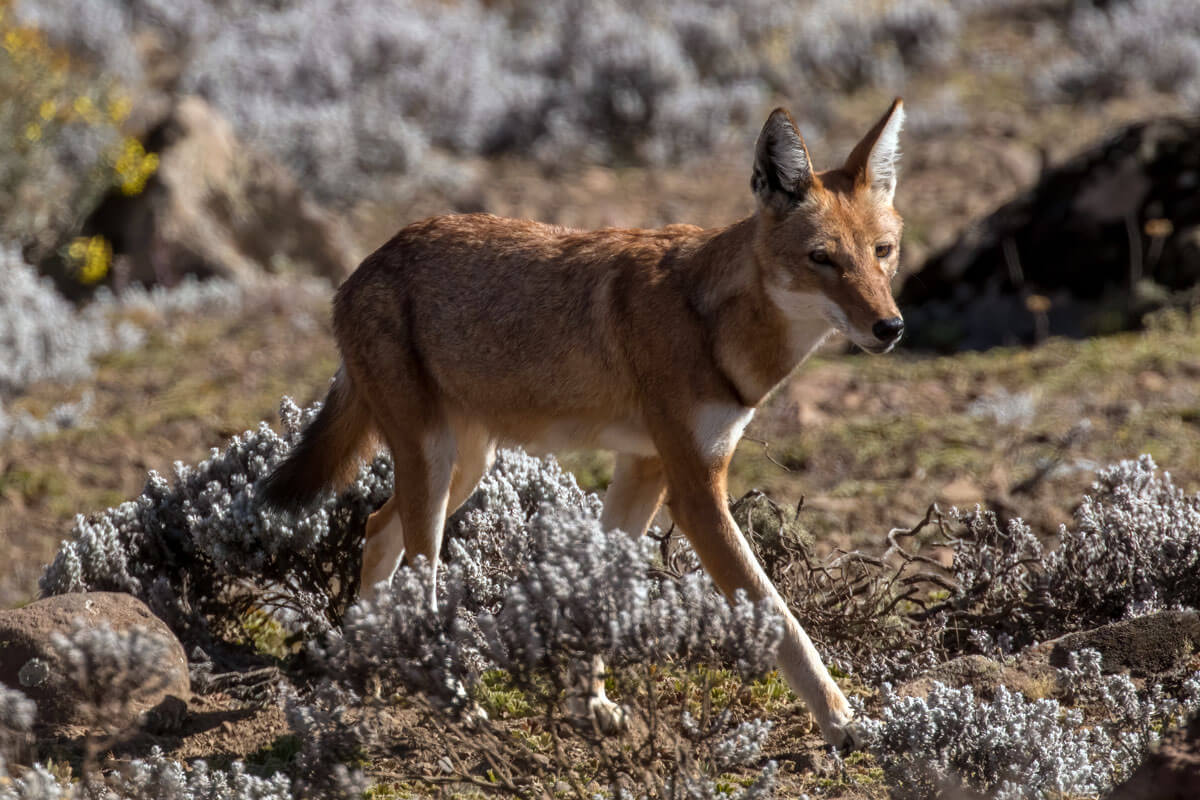The Ethiopian wolf is one of the world's rarest and most distinctive animals, found only in Ethiopia's highlands. With its striking appearance, specialized diet, and complex social behaviors, the Ethiopian wolf is a remarkable species that is well worth learning more about.
This article will look at some of the most fascinating facts about the Ethiopian wolf, such as its habitat, nutrition, hunting habits, and conservation status. We can better understand the value of conservation as well as the contribution that sustainable tourism can play in protecting endangered species like the Ethiopian wolf through learning more about this unique animal and the threats to its survival.
Facts About The Ethiopian Wolf
1. Appearance
The Ethiopian wolf is a striking animal, with a reddish-brown coat and long, slender legs. They have a distinctive white patch on their throat and a black tail tip. Their fur is long and thick, which helps to protect them from the cold.

2. Size
The Ethiopian wolf is a medium-sized canid, with males typically being larger than females. Here is a table showing the average weight and size of both males and females:
| WEIGHT (KG) | HEIGHT (CM) | LENGTH (CM) | |
|---|---|---|---|
| Males | 14 | 50 | 100 |
| Females | 11 | 45 | 95 |
To compare, the Ethiopian wolf is slightly larger than a coyote but smaller than a grey wolf or a leopard.
3. Habitat
The Ethiopian wolf is found exclusively in the Afro-alpine regions of Ethiopia, which are high-altitude grasslands and heathlands above 3,000 meters. They are most commonly found in the Bale Mountains National Park.

4. Diet
The Ethiopian wolf is a specialized carnivore, with over 90% of its diet consisting of rodents such as mole rats and grass rats. They also occasionally eat birds, hares, and small antelopes. On average, an Ethiopian wolf consumes about 600 grams of food per day, which is equivalent to around 15% of its body weight.
5. Hunting Behaviour
Ethiopian wolves are highly skilled hunters, using their keen sense of hearing and smell to locate prey. They hunt alone or in pairs, stalking their prey until they are close enough to pounce on them. They often use a high-pitched bark to coordinate their hunting efforts.
6. Reproduction
Ethiopian wolves form monogamous pairs and breed once a year between August and November. After a gestation period of around two months, females give birth to litters of two to six pups.
The puppies are raised by both parents and are weaned at around two months of age. Ethiopian wolves have a lifespan of around six to eight years in the wild.

7. Threats
The Ethiopian wolf faces many threats, including habitat loss, disease, and hunting by humans. They are also at risk of hybridization with domestic dogs, which can dilute the genetic integrity of the species.
8. Close Relatives
The Ethiopian wolf is the only species in its genus and is considered to be the most genetically distinct canid in the world. Its closest living relatives are thought to be the grey wolf and the coyote.
9. Conservation Status
The Ethiopian wolf is classified as endangered by the International Union for Conservation of Nature (IUCN). It is estimated that only around 500 individuals are remaining in the wild.
This low number in addition to a very limited and specific habitat, makes the Ethiopian wolf one of the most at-risk animals in Africa. Much more than mountain gorillas which are around 1000 individuals spread in Uganda, Rwanda and DR Congo.
Final Thoughts
The Ethiopian wolf is a unique and intriguing animal that is under threat of extinction. To safeguard the Ethiopian wolf, we must take action to preserve their habitat and limit human influence.
Sustainable tourism may help conservation efforts by providing financing for conservation initiatives and raising awareness about the necessity of conserving endangered species. We can safeguard the Ethiopian wolf by learning about it and supporting conservation initiatives.
